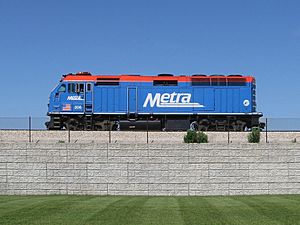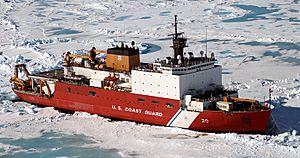Diesel–electric powertrain facts for kids

A diesel–electric transmission is a special way that some vehicles use power. It means a diesel engine creates electricity, and then electric motors use that electricity to move the vehicle. You can find this system in many types of transport, like trains, ships, and even some large trucks. It's similar to how petrol engines can also be linked to electric systems.
This system is very useful for trains because electric motors can give full power right from the start, even when the train is stopped. Diesel–electric systems are also used in marine transport (like submarines) and some land vehicles.
Contents
How it Works
The cool thing about diesel–electric transmission is that it doesn't need a traditional gearbox. Instead, the diesel engine powers a machine called an alternator. This alternator turns the engine's mechanical power into electrical energy. Then, this electrical energy powers traction motors, which are what actually make the vehicle move.
Sometimes, the electricity goes straight to the motors. Other times, it might first charge rechargeable batteries, making the vehicle a type of hybrid electric vehicle. This system is often called "electric transmission" because it's like how petrol engines or gas turbines can also use electricity to move vehicles.
Good and Bad Points
Diesel-electric systems are a type of Continuously variable transmission. This means they can smoothly change how much power they send to the wheels.
One big advantage of not having a gearbox is that there are no jerky gear changes. This makes the vehicle accelerate very smoothly. However, there are some downsides. Diesel-electric systems can be more complicated to build, cost more money, and some energy can be lost when it's converted from mechanical to electrical power and back again.
Ships

The very first ship to use a diesel engine was also the first diesel–electric ship! It was a Russian tanker called the Vandal, launched in 1903. Later, in the 1920s, some ships started using steam turbines to make electricity for propulsion. More recently, diesel–electric power has become popular for surface ships. For example, two Finnish coastal defense ships built in 1928–1929 were among the first to use this system. It was also used in diesel-powered icebreakers.
During World War II, the United States Navy built some diesel–electric warships. Modern diesel–electric ships, like cruise ships and icebreakers, often use electric motors inside special pods called azimuth thrusters. These pods can turn 360 degrees, making the ships super easy to steer. The Symphony of the Seas, one of the biggest passenger ships, uses this system.
Some ships even combine different power sources. The Queen Mary 2 cruise ship has diesel engines and gas turbines. All of them generate electricity, which then powers the ship's propellers. This is a clever way to use fast-spinning turbines to drive slow-spinning propellers without needing huge gears.
Submarines
Most early submarines had a direct link between their diesel engine and the propeller when on the surface. When they went underwater, they would switch to electric motors powered by batteries. This was like a "parallel" hybrid system, where both the engine and motor could connect to the same shaft.
However, in a true diesel–electric submarine, the propellers are always driven by electric motors. The diesel engines are only used to generate electricity, which charges the batteries and powers the motors. This system has a few disadvantages, but the benefits are much greater. One big advantage is that it makes the submarine much quieter when it's on the surface, because the noisy engine is separated from the outer hull. Some nuclear submarines also use a similar system, where a nuclear reactor creates steam to power generators.
The Swedish Navy was one of the first to use true diesel–electric systems in submarines, starting with HMS Hajen in 1904. The United States Navy also started using it in the 1930s with their Porpoise class submarines. After World War II, this system became the main way to power regular submarines.
Railway Locomotives
During World War I, there was a need for trains that didn't produce a lot of smoke. While diesel technology was still developing, some early attempts were made with petrol–electric trains.
In the 1920s, diesel–electric technology began to be used in "switcher" locomotives. These are trains used to move cars around in rail yards. The American Locomotive Company (ALCO) started making these in 1931. In the 1930s, this system was also used for "streamliners," which were the fastest trains of their time.
Diesel–electric power became very popular for trains because it made it much simpler to send power to the wheels. It was also more efficient and needed less maintenance. A regular diesel locomotive would need a huge number of gears to keep its engine running well, but linking the diesel engine to a generator solves this problem.
Road and Other Land Vehicles
Buses
Diesel-electric buses have also been made, including hybrid systems that can run on and store electricity in batteries. Companies like Allison Transmission and BAE Systems make the hybrid systems for these buses. You can find these systems in buses from New Flyer Industries, Gillig Corporation, and Orion Bus Industries. Mercedes-Benz also makes its own diesel–electric system for its Citaro buses.
Trucks
You can find diesel–electric systems in some very large machines:
- Huge mining trucks, like the Liebherr T 282B or LeTourneau L-2350 wheel loader.
- NASA's Crawler-Transporters, which move rockets to the launchpad.
- Commercial trucks like the Mitsubishi Fuso Canter Eco Hybrid.
- Some semi-trucks are being changed to use a diesel-electric hybrid system.
Concept Vehicles
In the car world, designers are working on diesel engines combined with electric transmissions and batteries for future cars. Programs like the Partnership for a New Generation of Vehicles worked on diesel hybrid cars.
Some examples of concept cars that used this idea include:
- The General Motors Precept
- The Ford Prodigy
- The Dodge Intrepid ESX
- The Ford Reflex (a diesel hybrid concept car)
Military Vehicles
Diesel–electric power has been tested in some military vehicles, like tanks. For example, the prototype TOG1 and TOG2 super heavy tanks from World War II used two generators powered by diesel engines. Newer prototypes, like the SEP modular armoured vehicle, also explored this technology. Future tanks might use diesel–electric drives to save fuel and make the power system smaller, lighter, and quieter.
See also
- DC distribution system (ship propulsion)
- Petrol-electric transmission
- Turbine-electric transmission
- Turbo-electric transmission
 In Spanish: Transmisión diésel-eléctrica para niños
In Spanish: Transmisión diésel-eléctrica para niños


